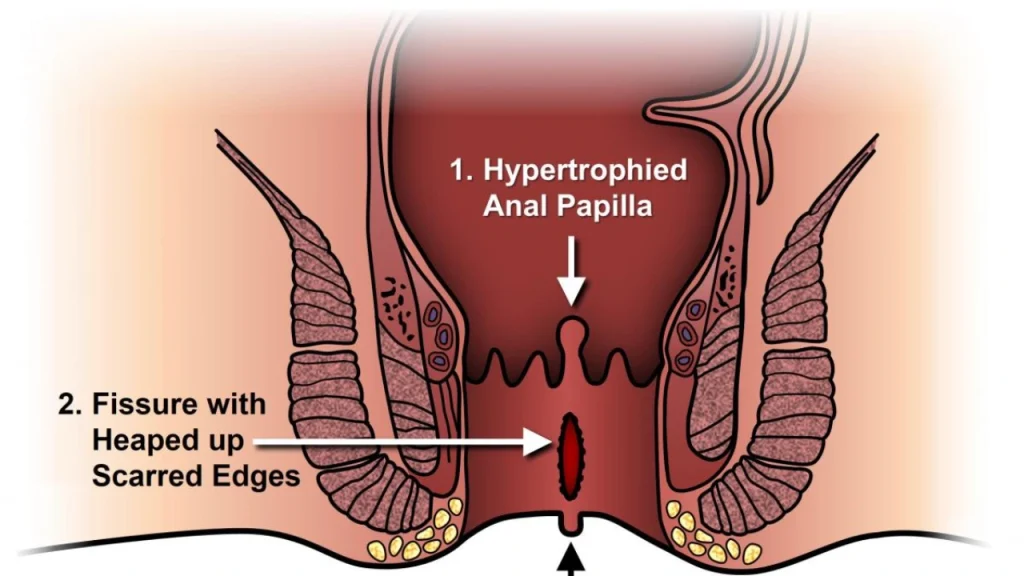Do you feel a sharp, tearing pain when you pass stool, almost like passing glass? Do you see a few drops of bright red blood on the toilet paper or in the toilet bowl? Does the pain last for some time even after you have finished? This fear might even make you want to avoid going to the toilet.
If this describes what you are going through, this guide can help. We will explain what a fissure is in simple, clear terms, so you can understand this common and painful condition.
What Exactly Is a Fissure?
An anal fissure is a small cut or tear in the delicate skin lining your back passage (anus). Think of it like a paper cut, but in a very sensitive area. This small tear is what causes the sharp pain and bleeding during and after a bowel movement.
Fissures are very common, but many people feel shy to talk about them. It is important to know that this is a medical condition, not a sign of poor hygiene.

What Causes a Fissure?
The most common cause of a fissure is passing a large or very hard stool. This stretches the anal canal and can tear the skin.
This often happens because of constipation. A diet low in fibre, not drinking enough water, and avoiding the urge to go to the toilet can all lead to hard stools. In some cases, long periods of diarrhea or even childbirth can also cause a fissure. The constant strain and pressure on the area are the main culprits.
Fissure, Piles, or Fistula? Knowing the Difference
Many people in India get confused between these three conditions. They are not the same. A fissure is a cut that causes a sharp, knife-like pain during bowel movements. Piles (hemorrhoids) are swollen blood vessels. They usually cause a dull ache, itching, and sometimes a painless lump. A fistula is a small tunnel under the skin that leaks pus or fluid. It causes constant discomfort and swelling. The main sign of a fissure is sharp pain. If that is your primary symptom, you might have a fissure.
How Are Fissures Treated?
The good news is that most fissures heal on their own with simple care at home. The goal is to keep your stools soft to give the tear a chance to heal. You can do this by eating more fibre-rich foods like fruits, vegetables, and isabgol (psyllium husk). Drinking plenty of water throughout the day is also very important.
Another helpful home remedy is a sitz bath. This means sitting in a tub of warm water for 10 to 15 minutes, a few times a day. The warm water soothes the area and helps the muscle relax, which improves blood flow and helps healing. If home care does not work, a doctor might give you a special cream or ointment to apply. For a fissure that does not heal for a long time (a chronic fissure), a doctor might suggest a minor surgical procedure to fix the problem permanently.
Key Takeaways
A fissure is simply a small tear in the skin of the anus, most often caused by constipation. The key symptom is a sharp pain during bowel movements, sometimes with a little bright red blood. Most fissures can be healed at home by softening your stool with a high-fibre diet and plenty of water. If the pain continues, it is best to see a doctor.
Frequently Asked Questions (FAQs)
Q: Is a fissure a serious problem?
A: No, a fissure is not usually a dangerous condition. It is a common problem that causes a lot of discomfort, but it is not a sign of a major disease like cancer. However, if it doesn’t heal, it is important to get it checked by a doctor.
Q: Can spicy food cause a fissure?
A: Spicy food does not cause a fissure. However, if you already have a fissure, very spicy food can irritate the tear and make the burning feeling worse when you pass stool. It is best to eat a simple, less spicy diet while it heals.
Q: How long does it take for a fissure to heal?
A: With proper care like a high-fibre diet and sitz baths, most fissures start to feel better in a week or two and can heal completely in four to six weeks. If it lasts longer, it is called a chronic fissure, and you should consult a doctor.
